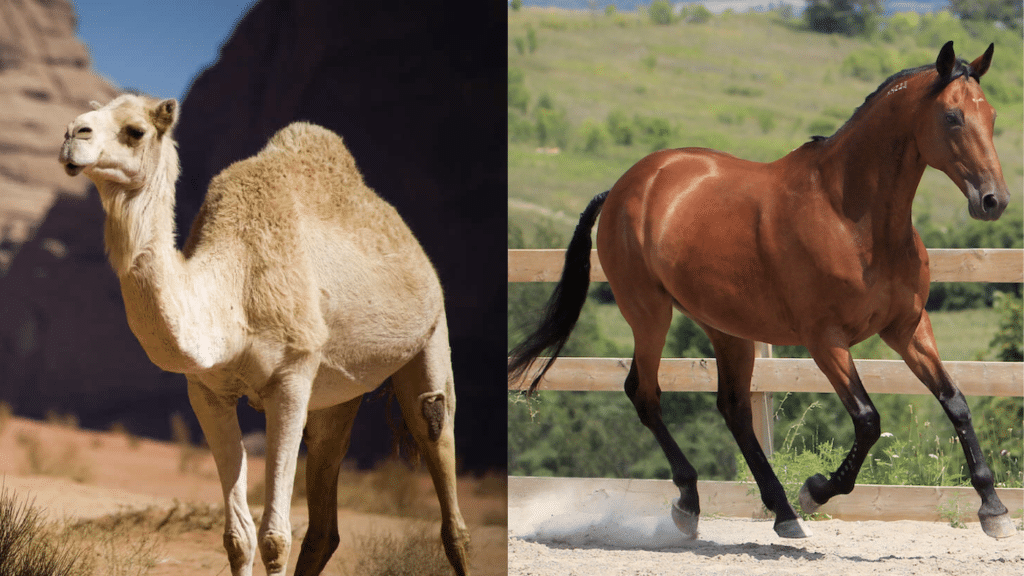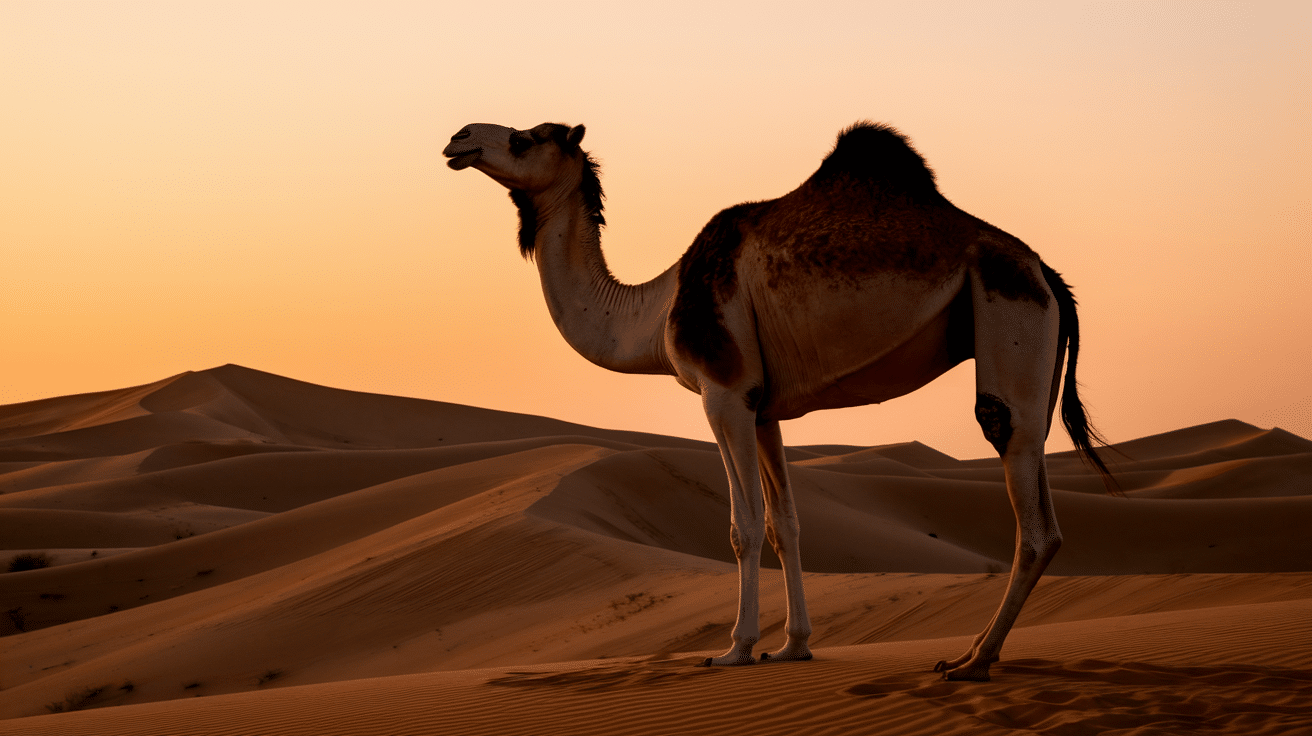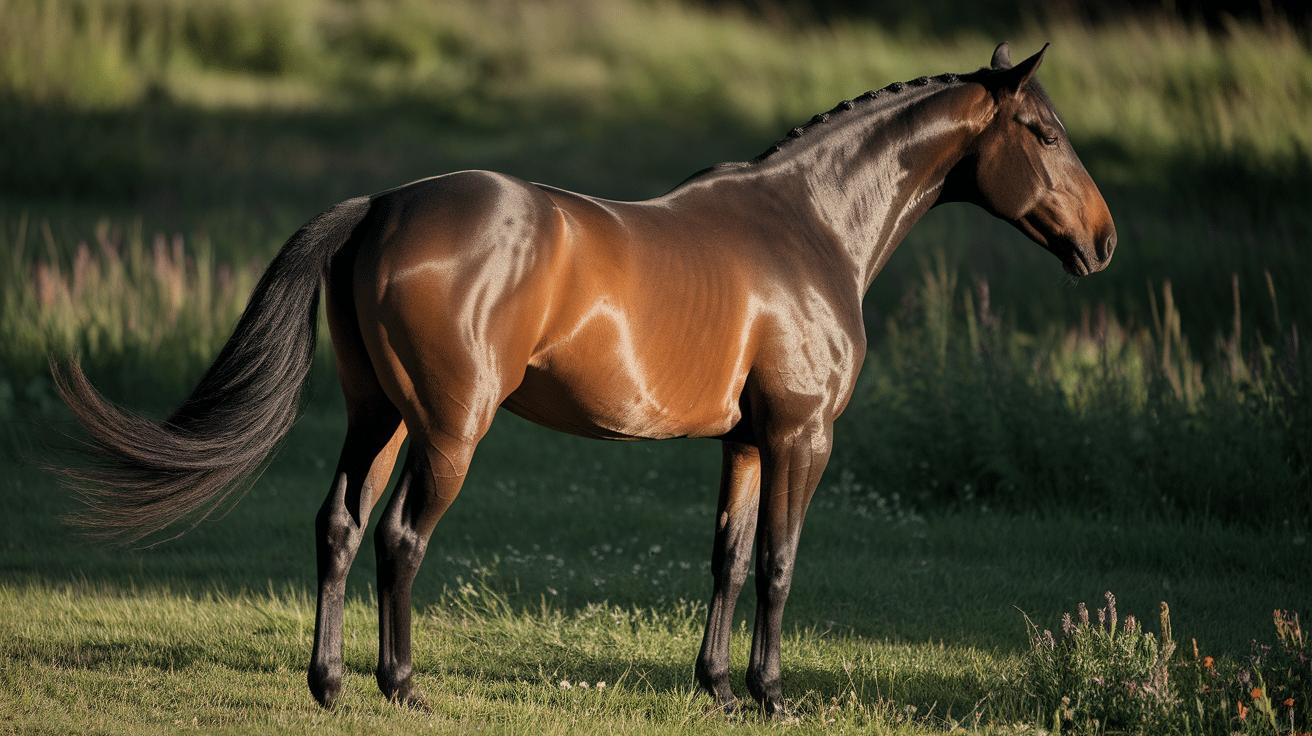A camel can survive weeks without water, while a horse needs to drink daily. One conquers scorching deserts with ease, the other charges across battlefields at breathtaking speed.
These two powerhouses have carried humans through history in completely different ways.
The camel is built like a living tank for the world’s harshest landscapes. The horse is engineered for pure speed and grace. From ancient Silk Road caravans to cavalry charges, both have shaped civilizations.
One stores water like a walking reservoir; the other can outrun the wind.
But which one would actually win in a head-to-head desert showdown?
The answer might surprise you!
Origins of Camels and Horses
Camels first appeared 45 million years ago in North America. They spread to Asia and Africa, with humans taming them around 3000 BCE.
The dromedary became common in the Middle East and Africa, serving ancient civilizations for various purposes.
Horses emerged in North America 55 million years ago. Their domestication occurred around 4000 BCE in Central Asia, changing human mobility and warfare.
Horse-riding cultures built vast empires. Agricultural societies used horses for farming and transportation, while military powers depended on cavalry for conquests.
Camel vs Horse: Key Difference
Camels and horses, though both powerful creatures, have unique adaptations suited to their environments, showcasing differences in physical traits, speed, diet, and social behavior.
Camel
- Physical Characteristics: Tall animal (6-7 feet at shoulder) with fat-storing humps, curved neck, split upper lip, padded feet, and protective eyelashes suited for desert environments.
- Speed: Camels typically travel at 25 mph (40 km/h) maximum, but maintain a steady 3 mph (5 km/h) pace for days across desert terrain.
- Natural Habitat: Adapted to dry deserts and semi-dry regions across North Africa, the Middle East, and Central Asia, with the ability to handle extreme temperatures and minimal water.
- Diet: Consumes thorny plants and dry vegetation avoided by other animals, needs minimal water, and efficiently stores nutrients in humps during food scarcity periods.
- Social Structure: Forms small family groups led by dominant males, with a clear hierarchy shown through body positioning and communication through various vocalizations and stances.
- Lifespan: Survives 40-50 years, matures at 4-7 years, remains productive into their 30s, and maintains health despite harsh living conditions in desert regions.
- Behavior: Camels are social animals that form family groups, communicating through body language and vocalizations. They show protective behavior and calmness, especially toward younger members.
- Intelligence: Camels have excellent problem-solving abilities and strong memories, which help them navigate desert landscapes and remember water sources. They also demonstrate adaptability and strategic thinking in harsh environments.
Horse
- Physical Characteristics: Medium-sized animal (4.5-6 feet tall) with muscular body, straight neck, flowing mane, tail for insect control, hard hooves, and side-positioned eyes.
- Speed: Horses can reach 55 mph (88 km/h) at full gallop, with racing thoroughbreds averaging 40 mph (64 km/h) during short sprints.
- Natural Habitat: Lives on grassy steppes and plains with moderate climates, requiring open spaces for movement, constant grazing, and regular access to water sources.
- Diet: Grazes on grasses for 15-17 hours daily, drinks 5-10 gallons of water, cannot digest thorny plants, and needs consistent feeding for digestive health.
- Social Structure: Creates family bands with stallions, mares, and offspring, forms bachelor groups, builds lifelong bonds between females, and uses body language for communication.
- Lifespan: Lives 25-30 years normally, with some reaching 40+, matures by age 5-7, works productively until 15-20 years, and needs increased care with age.
- Behavior: Horses form strong bonds within their groups, communicating through body language and sounds. They are affectionate, building lifelong relationships with other horses and humans.
- Intelligence: Horses are quick learners, able to solve problems and follow commands. They display strong memory, emotional intelligence, and adaptability, reacting to environmental and social cues.
Camel and Horse Riding Experience
| CATEGORY | CAMEL | HORSE |
|---|---|---|
| Movement & Feel | Side-to-side swaying motion similar to a ship at sea | Vertical up-and-down motion that feels more direct |
| Speed & Agility | Slower pace with steady strength for long routes | Faster and more nimble, with the ability to change pace quickly |
| Terrain Suitability | Excels on sand and in hot desert conditions | Performs best on firm ground and varied landscapes |
| Riding Control | Simple control system using a single rein and vocal commands | More complex control using two reins, leg pressure, and weight shifts |
| Beginner Experience | More passive riding with less skill required at a basic level | Demands active balance and engagement even for beginners |
Camel & Horse in Tourism Today
Desert tourism thrives on camel experiences across Morocco, Egypt, India, and Australia’s Outback.
From quick 30-minute rides to epic multi-day treks, these “ships of the desert” offer tourists an authentic glimpse into ancient travel methods and breathtaking landscapes that only camels can access.
Horse tourism gallops ahead with trail rides, ranch stays, and cultural experiences spanning Iceland’s volcanic terrain to city carriage rides.
These versatile animals connect tourists with local traditions and natural beauty in ways cars simply can’t match.
Sustainability and Economic Impact
Both industries now prioritize animal welfare through proper rest periods, weight limits, and trained handlers.
However, the economic ripple effect is massive, creating jobs for guides, handlers, and support services in rural communities where opportunities are often scarce.
This tourism doesn’t just showcase these magnificent animals; it provides sustainable livelihoods while preserving centuries-old cultural traditions.
The Bottom Line
Camels and horses have played crucial roles in shaping human history, each offering unique benefits and experiences.
Today, both animals continue to offer incredible experiences in tourism, connecting people to nature and culture.
As we enjoy these animals, it’s important to remember their welfare and the impact they have on local economies.
Whether riding through the desert or across open plains, camels and horses remain symbols of strength, companionship, and adventure.























